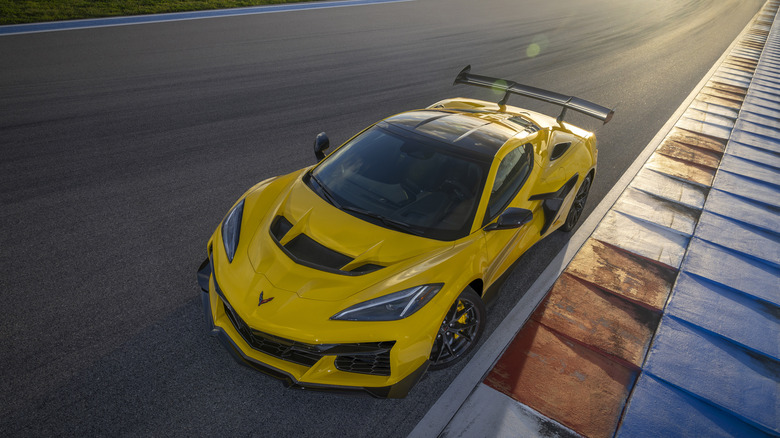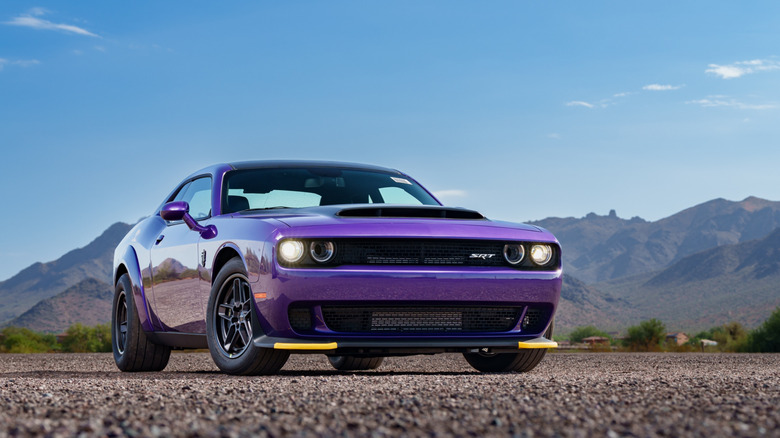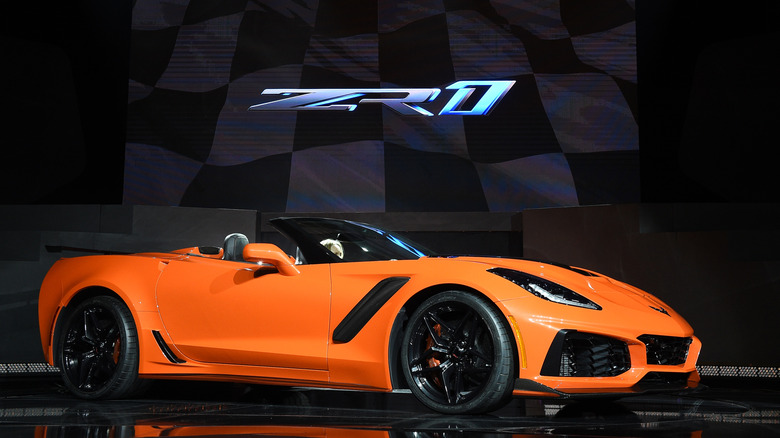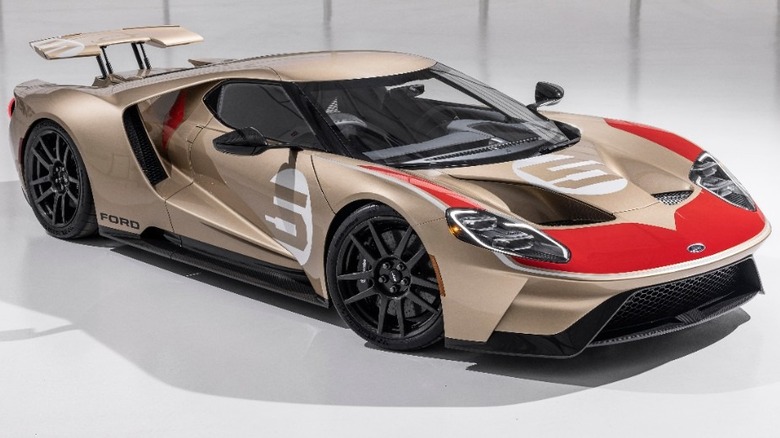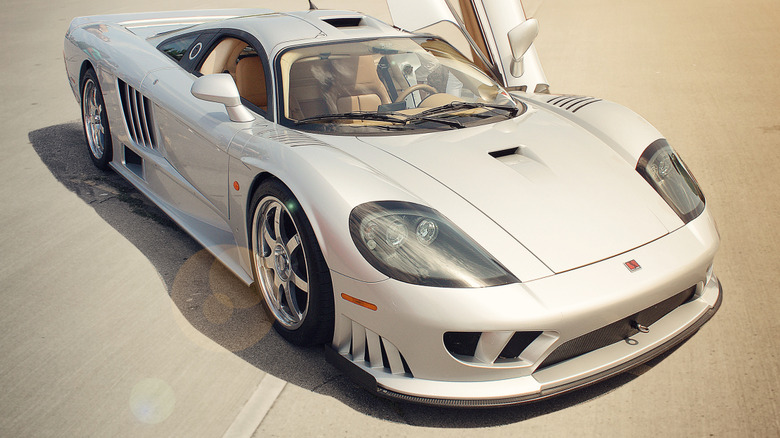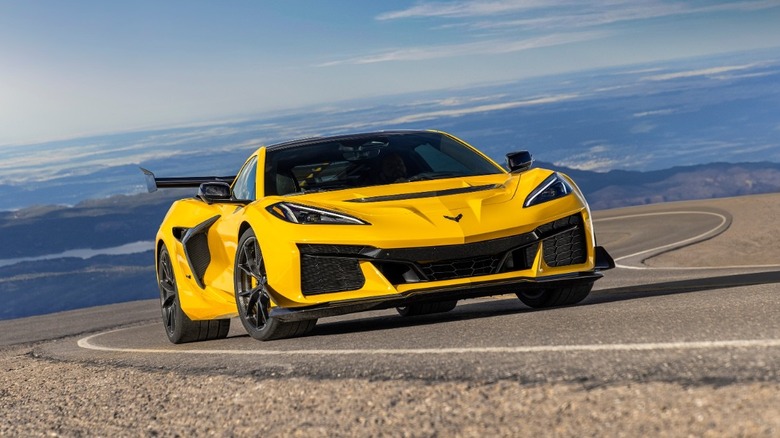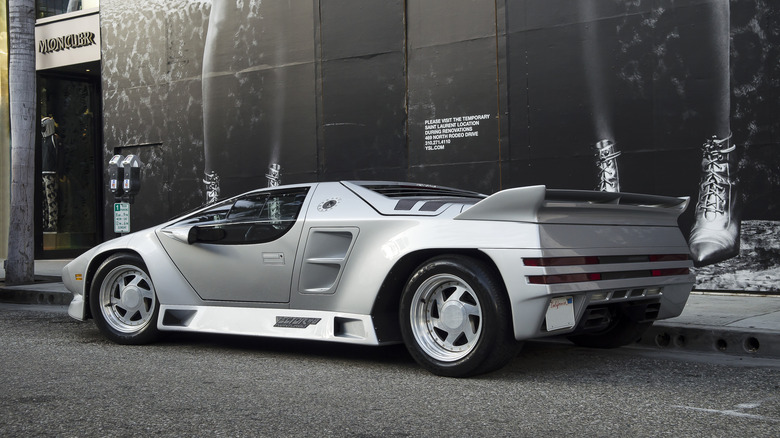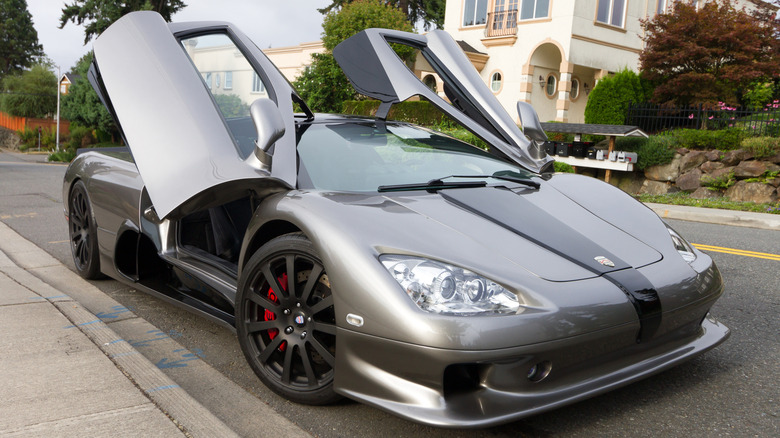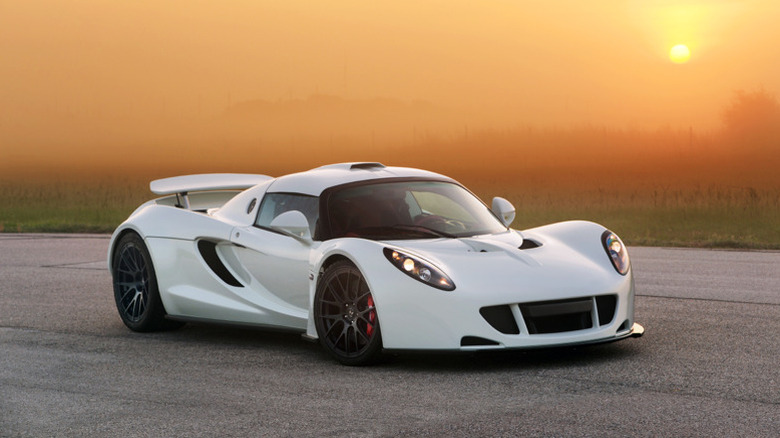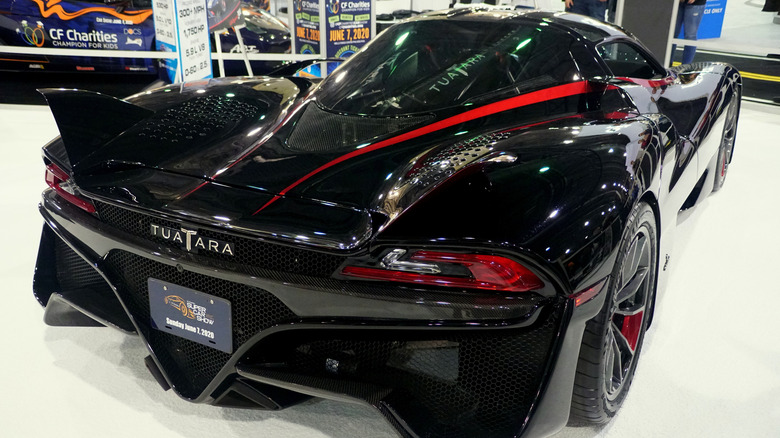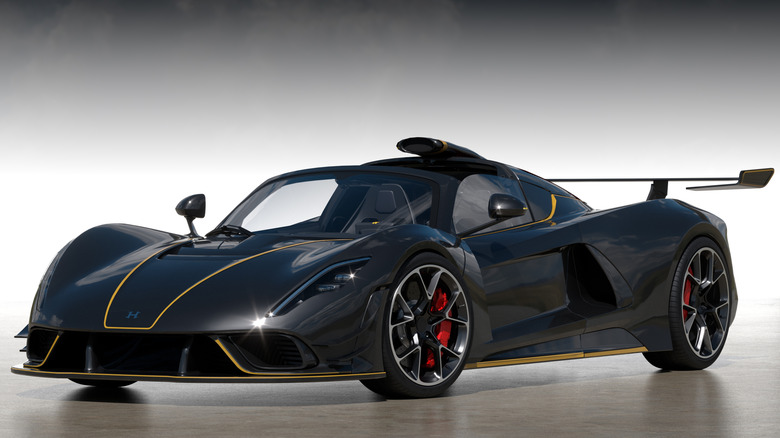10 Of The Fastest American-Made Cars
Bring up the topic of the fastest production cars in the world , and most folks will name European brands such as Ferrari, Lamborghini, Bugatti, or McLaren. However, knowledgeable car enthusiasts know that the USA belongs in this conversation, too. Some American supercar builders may not be as familiar to the average person, but the radar gun doesn't lie: some of the fastest American-made cars ever built can compete with any famous name from the Old World.
Some American supercar models roll out of the factory in dozens, rather than the hundreds or thousands that European brands often produce. An American manufacturer like Hennessey may challenge Bugatti, Ferrari, and others to build the fastest cars in the world, but with production runs of just a few dozen, Hennessey doesn't hold a candle to Ferrari's 10,000 cars per year . But in a way, that reflects the purity of their quest: these carmakers focus on breaking records on the track, not in the sales columns. Of course, Chevy, Ford, and Dodge all make appearances on this list, too, giving the average person hope of someday walking into a nearby dealership and driving away as a member of the 200 mph club.
This list requires deciding what counts as an American manufacturer. Dodge slips in by a whisker, as even though its fastest cars are built in Canada, Dodge is a US-based brand. Other, smaller manufacturers may or may not actually be making production cars at press time, so the revolutionary 3D printed Czinger 21C doesn't make this list — yet.
2018 and 2023 Dodge Demon
The 2018 Dodge Demon was a throwback to the days of street-legal muscle cars that were much more at home on the drag strip. In fact, it even came with two different keys: a black key for 500 horsepower and street-friendly driving, and a red key to really set it loose at the drag strip. There, the National Hot Rod Association (NHRA) certified the Demon's production-car run in the quarter-mile at a face-melting 9.65 seconds, reaching just a tick over 140 mph in the process.
This makes the Demon one of the quickest cars on this list. In fact, it was so quick that initially the Demon was banned by the NHRA. Top speed is a different matter: the Demon was limited to 149 mph by a speed governor, although without that restriction, it certainly could have gone much faster. After all, its supercharged 6.2-liter V8 generated 840 horsepower, well above the 707-horsepower Dodge Challenger Hellcat that it was based on. The thinking was that what happened within that quarter mile was all that mattered.
Dodge resurrected the nameplate one last time in 2023. This car was part of the Last Call series of Challenger and Charger models, and its full name was the Challenger SRT Demon 170. If you're wondering what the "170" means in this Dodge Demon's name, it allegedly is double the rating of E85 gas, the way the proof on a bottle of liquor is double the percentage of alcohol it contains. This reinforces the fact that the SRT Demon 170 runs on regular E85 gas. And boy does it run: with a boost to 1,025 horsepower, it hits the quarter-mile in a mind-blowing 8.91 seconds.
2019 Chevrolet C7 Corvette ZR1
The original Corvette ZR1 earned the nickname "King of the Hill" way back in 1990 for being the fastest car in any mainstream dealership in America. When Chevy resurrected the ZR1 designation for a new generation in 2019, its engineers knew they had quite a legacy to live up to. Cars are much faster today than they were in 1990, so to be the king of the hill again, the new ZR1 had to really blow the doors off the competition. The result was a 755-horsepower all-American supercar.
The crowning achievement of the C7 generation of the Corvette, the 2019 ZR1 dominated the competition. The LT4 engine that powered ordinary 'Vettes already cranked out 650 horses, so the ZR1 had to top that. Chevy created the LT5 engine, a 6.2-liter supercharged V8 monster throbbing with 755 horsepower and a tire-smoking 715 lb-ft of torque. Transmission choices included a 7-speed manual, as well as an 8-speed automatic for drivers who were content to let an auto gearbox handle that mind-numbing power output. Magnetic ride control and Brembo brakes helped corral that power in the curves.
Chevy limited the ultimate 'Vette's top speed to 215 mph, although it was certified to 212 mph. That certification came from a two-way average, so it's possible that the test car may have exceeded that speed in one direction or the other. Either way, the ZR1 allowed any buyer who could come up with just under $120,000 to enter the 200 mph club with room to spare. That's a lot of scratch for a Chevy, but a bargain compared to Euro-supercars that cost two or three times as much.
2017-2023 Ford GT
The original Ford GT40 was one of the most beloved American performance cars ever built, winning the 24 Hours of Le Mans and inspiring the movie "Ford v Ferrari" about the history of the rivalry between Carroll Shelby's GT40 and Enzo Ferrari's creations. Ford created a worthy successor in the form of the Ford GT in 2005, and resurrected the name again for the 2017 through 2023 model years.
The GT's swan song, the 2023 GT Mark IV, was a track-only model, unlike the other 21st-century GTs. Ford gave its supercar an extreme performance makeover for this model year with the aim of entering hypercar territory, and by all accounts they succeeded. In keeping with its racing heritage, this edition was very exclusive: only 67 were built at a very serious price of $1.7 million.
It might be surprising to learn that Ford's wealthiest customers were buying a V6-powered car, but this was no ordinary V6. This twin-turbo 3.8-liter EcoBoost V6 produced more than 800 horsepower, propelling the GT to a top speed in the ballpark of 216 mph. With a Multimatic racing suspension, a long-wheelbase chassis, and Michelin Pilot Sport racing tires, it can handle the curves of any GT racing circuit. A lightweight carbon-fiber "Long Tail" body features a large wing spoiler to increase downforce, and a race-oriented dual-clutch seven-speed automatic channels the Mark IV's power to the wheels. This all adds up to proper race-car performance. In fact, in early 2024, a Ford GT Mark IV crushed the lap record at the Circuit of the Americas near Austin, Texas. This 20-turn racecourse challenges a car's limits, and the Mark IV handled it with ease, setting a new record of just over one minute and 58 seconds.
Saleen S7
In the first decade of this century, an American-built supercar with 850 horsepower could make jaws drop. It still does, with a body so low and wide that it doesn't so much slice through the atmosphere as slip under it. Supercar lovers know the Saleen S7 made it from design concept to production in an incredibly short 18 months, a testament to the engineering prowess of Steve Saleen and his team.
Mr. Saleen is something of an automotive renaissance man, beginning his career in the 1970s as a successful race car driver. In 1984 he founded Saleen Autosport, now known as Saleen Automotive, to bring racing technology to street cars. Saleen continues to create modified vehicles including Mustangs, F-150s, Broncos, and Teslas, and has a forthcoming supercar called the Saleen 1. But for now, Saleen's crown jewel remains the S7, a curvaceous, mid-engined, long-tailed supercar. The original S7, introduced in 2000, generated 550 horsepower from a 7.0-liter Ford V8. This already made it the most powerful street-legal American car, but Steve Saleen was after Ferrari, and he knew it was a moving target. To keep pace with cars like the Ferrari Enzo, introduced in 2004, Saleen added twin turbochargers to the 2005 S7 to create the S7TT.
The S7TT's turbos boosted the horsepower to 750, along with 700 lb-ft of torque. Saleen claimed a top speed of over 250 mph, but finding a source that verified that on the track is difficult. The original 550-HP S7 achieved 200 mph, though, so the S7TT was undoubtedly even faster than that. Steve Saleen definitely upped America's supercar game.
2025 Chevrolet C8 Corvette ZR1
A Chevrolet Corvette ZR1 makes this list for the second time, as Chevy continues to defend the hill of horsepower. As a 2025 Chevy model, this is the fastest car on this list that you can currently buy from a dealership. The ZR1 edition of the C8 Corvette is the first factory-spec 'Vette to break the 1,000 horsepower mark, is more powerful than almost any of its European supercar competitors, and for a fraction of the price, too.
With 1,064 horsepower and an earth-moving 828 lb-ft of torque the ZR1 is, to date, the fastest Chevy of all time. Its 5.5-liter LT7 engine sports a dual-overhead-cam design and gets its boost from twin turbochargers, a first for a 'Vette. It has a new intake system, specially designed valves, and other features designed to handle the tremendous amount of energy and heat this beast of an engine creates. The engine has a flat-plane crankshaft, something typically found in race cars and exotic supercars, and an eight-speed dual-clutch transmission channels the power to the rear wheels; no manual transmission is available.
Final performance figures aren't available at press time, but Chevy claims a 0-60 time of 2.3 seconds and a quarter mile time of 9.6 seconds. What about top speed? A press release states that a ZR1 hit 233 mph at a test track in Papenburg, Germany, and not with a test driver, but with GM president Mark Reuss behind the wheel!
1990s Vector W8 Twin Turbo
Here's a blast from the past that even some car enthusiasts have forgotten. The fact that the Vector W8 Twin Turbo makes this list even though it debuted way back in 1990 testifies to how much faster it was than almost anything else in its day. Some consider it one of the most expensive car flops of all time, but it played a role in creating the American supercar culture. Admittedly, the development of the W8 followed a troubled trajectory. Its creator, Gerald A. Wiegert, displayed his first prototype in 1972, and it would take 18 years to reach the market. All told, only 18 production examples were ever built. Wiegert, who died in 2021, was definitely a study in determination, and toward the end of his life he was even trying to build a new Vector model.
Wiegert's dream was powered by a 6.0-liter twin-turbo V8 that was related to a motor found in the Camaro. But in the W8, this engine blasted out 625 horsepower. In an era when many cars still produced fewer than 100 horsepower and even the legendary Buick Grand National GNX – also a twin-turbocharged car — only pumped out 276 horses, 625 horsepower was positively insane. But wait, there's more: The W8 driver had the option to turn a boost knob to increase that output to 730 horsepower.
Vector Aeromotive claimed a 242 mph top speed for its car. If true, then even today that would put it in very rarefied company, never mind during the pre-Gulf War era. Its $300,000 price in 1990 (about $724,000 in late-2024 money) also put it in elite company. Reliability problems plagued the W8, but one could argue that's part of the supercar experience, too.
SSC Ultimate Aero TT
SSC North America, founded by Jerod Shelby, focuses on speed. In the process, it may have created the most underrated American supercar of all time. In its most advanced form, the Ultimate Aero TT's Corvette-sourced, 5.7-liter, twin-turbocharged V8 produced 1,183 horsepower and, get this: 1,094 lb-ft of torque. This powertrain, located amidships, delivered its insane amount of grunt to the rear wheels only, as all-wheel-drive supercars were still a few years away.
The Ultimate Aero TT sported a body made entirely of carbon fiber that also resembled the Lamborghini Diablo, right down to its gull-wing doors. This high-tech body weighed just 131 pounds and contributed to an extremely low total weight, as did an aluminum engine block. In fact, its weight (in pounds) to horsepower ratio was only 2.33, which was a record for the time.
While the Ultimate Aero TT never officially reached SSC's claimed theoretical top speed of 273 mph, in September of 2007 it achieved a Guinness world record with a two-way average speed of 256.14 mph. This made it faster than the Bugatti Veyron, which was widely acknowledged to be the fastest car on earth with an unofficial record of 252.5 mph. The official record holder at the time was the Koenigsegg CCR, whose 241 mph speed was completely blown away by the Ultimate Aero TT. Score one for the Yanks!
2011-2017 Hennessey Venom GT
The Hennessey Venom GT is a 272 mph, 1,200 horsepower hypercar produced from the 2011 through 2017 model years. Even today, that horsepower count is staggering, but in its decade, it was nearly unheard of. The Venom GT's swoopy, high-tech appearance calls to mind the old cliche of looking fast even when standing still. The body is made of carbon fiber for extreme weight savings and is actually based on the Lotus Elise/Exige platform, but that's as far as its foreign components go. The rest of the Venom GT is as American as apple pie and baseball.
That includes the heart of the beast, a mid-engine, 7.0-liter, OHV, twin-turbocharged V8 that company founder John Hennessey and his team originally created for use in their own special edition of the Dodge Viper. Maximum horsepower totals 1,244, although the driver can select between 800, 1,000, and 1,244 horsepower, depending on the driving mission. The rest of the car bristles with similar high-tech hardware, including forged monoblock wheels and carbon-ceramic brake rotors.
All this go-fast hardware translates into serious speed. Record-breaking speed, in fact. In 2014, the Venom GT set a new world two-way speed record of 270.49 mph on the John F. Kennedy Space Center's space shuttle runway. This is just one of a number of records collected by the Venom GT, including a 0-200 mph time of 14.51 seconds. The Venom GT's quarter-mile time is 9.92 seconds.
SSC Tuatara
The SSC Tuatara doesn't just look fast, it is fast; to the tune of 295 mph. In fact, it broke the world speed record. Twice. Like other vehicles in the hypercar segment, the Tuatara saves weight via the extensive use of space-age materials, such as a carbon fiber monocoque body. This lightweight body is driven by a twin-turbo V8 that produces a mind-bending 1,350 horsepower. But if that incredible number isn't enough for you, keep in mind that this power rating is for 91-octane gasoline. Switch to ethanol or methanol for fuel, and the power output jumps to 1,750 horsepower. Let that number sink in for a few minutes.
SSC has designed a gearbox it calls a "Robotized Manual 7-speed," which is integrated with an Automac AMT to control selection and movement of the gears with millisecond accuracy. A powerful microprocessor and electrical operation of mechanical components help this gearbox keep up with the raw power from the engine.
In January 2021, SSC brought a Tuatara to the Kennedy Space Center runway along with observers from multiple organizations. The car achieved a 282.9 mph two-way average , stealing the world production car speed record away from Koenigsegg. Two years later, it broke its own record on the same runway with a two-way average of 295.0 mph.
Hennessey Venom F5
Not that long ago, supercar manufacturers raced to break the 200 mph barrier. The Hennessey Venom F5 upped the ante by targeting the 300 mph mark, and exceeding it with ease — at least in theory. Nonetheless, it's definitely one of the fastest V8 cars when ranked by top speed .
The Venom F5 – named for the tornado rating scale on which an F5 storm has the fastest winds — certainly has the gear for triple-triple-digit speed quest. Its twin-turbocharged, 6.6-liter V8 "Fury" engine generates a seemingly impossible 1,817 horsepower, all pushing only 2,998 pounds of car. Carbon-ceramic brakes can bring all that supercharged wrath to a quick halt, while also saving weight and not fading on the track.
The cockpit emulates fighter jets with an aircraft-style yoke steering wheel. It also features a minimalist design to allow the driver to focus on the act of driving. Carbon-fiber bucket seats cushioned with leather are complimented by a carbon-fiber steering wheel, showing how Hennessey's obsession with reducing weight extends to every aspect of the car.
The Venom F5 is a true speed demon. Hennessey claims a hypothetical top speed of 328 mph, but as of 2024 it's still locked in a three-way chase with Bugatti and Koenigsegg for bragging rights to the title of fastest production car on the planet. And it is a production car, although its production numbers are low. Only 24 Venom F5 coupes were produced, all of which sold out. However, a roadster version with a removable license plate top is available for very well-heeled drivers who want to experience the wind of an F5 tornado in their hair.
